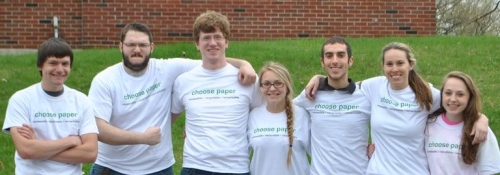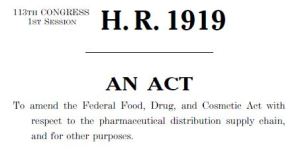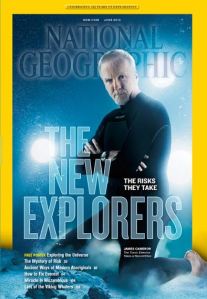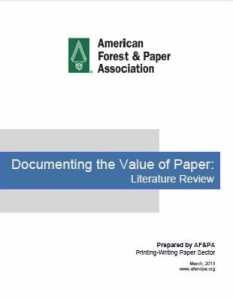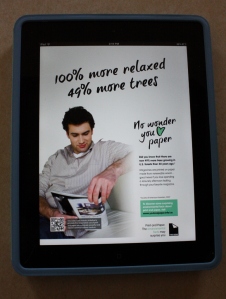Over the last year, Two Sides made the transformation from new kid on the block to familiar advocate for the sustainability of print on paper. Our membership continues to grow and our collective voice is getting stronger every day. Even more exciting, we’ve extended our reach and effectiveness where it really counts – to the C-suites of many major U.S. companies and to American consumers. Following the strategic guidance of the Two Sides U.S. Board of Directors, our ambitious 2012-2013 Marketing and Communications Plan built on past successes and incorporated new efforts to put an end to anti-paper environmental marketing claims and share the news that Print and Paper Have a Great Environmental Story to Tell.
Membership – As of July 1, 2013, 2013, Two Sides U.S. has 60 commercial members from across the Graphic Communications Supply Chain, including paper producers, merchants, printers, envelope manufacturers, and 34 allied organizations and partner members. Internationally, the Two Sides network includes more than 1,000 members.
Paperless Claims Initiative – Two Sides launched this nationwide education effort in July 2012 to encourage leading U.S. companies to end the use of unsubstantiated marketing claims that electronic billing and customer communications are better for the environment than paper communications. The campaign initially engaged about 50 companies, primarily in the financial services, telecommunications and utilities industries. While time-consuming, our systematic educational approach is working. Ten companies have removed their anti-paper environmental claims and we are currently in discussions with several others. In March 2013, we launched Phase II of this initiative with a second round of communications. With input from members and others, our potential target list has grown to more than 200 companies. This initiative is patterned after a similar, highly successful program conducted by Two Sides in the United Kingdom.
 Ad Campaign – To address misconceptions about the sustainability of print on paper identified by Two Sides research, the No Wonder You Love Paperad campaign was designed to educate consumers that print media is sustainable, made from a renewable resource and supports sustainable forest management, and to promote the reading experience and enjoyment of printed magazines and newspapers. The campaign includes a user-friendly companion website for consumers (www.youlovepaper.info/us). To date, several ads have appeared in Print Solutions and Gravure magazine. The first consumer-facing ads appeared in the digital version of Inc. magazine in April and most recently in the June issue of National Geographic. Over the next year, Two Sides is seeking free advertising space in business, trade and consumer magazines and newspapers.
Ad Campaign – To address misconceptions about the sustainability of print on paper identified by Two Sides research, the No Wonder You Love Paperad campaign was designed to educate consumers that print media is sustainable, made from a renewable resource and supports sustainable forest management, and to promote the reading experience and enjoyment of printed magazines and newspapers. The campaign includes a user-friendly companion website for consumers (www.youlovepaper.info/us). To date, several ads have appeared in Print Solutions and Gravure magazine. The first consumer-facing ads appeared in the digital version of Inc. magazine in April and most recently in the June issue of National Geographic. Over the next year, Two Sides is seeking free advertising space in business, trade and consumer magazines and newspapers.
Response to Anti-Paper Initiatives – In addition to its focused campaign on addressing paperless claims, Two Sides often responds to new initiatives aimed at encouraging consumers to “go paperless” for environmental reasons. Most notable during the past year were responses to Toshiba’s proposed “No Print Day” and Google’s participation in the Paperless2013 initiative. Both were successful in removing anti-paper green messages thanks to the actions of Two Sides and it’s allies.
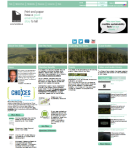 Website – The Two Sides website, www.twosides.us, continued to be a valuable resource for members and the general public, providing the latest news, research, case studies, tools and useful facts about the sustainability of print and paper. We added a new section on Environmental Marketing Best Practices for Print and Paperin late 2012 and will be adding a new section on Responsible Production and Use of Print and Paper in the coming months. The site is updated monthly and members receive email notification of new items that have been added. For the quarter ended March 31, 2013, the website had more than 10,000 visits. There are about 400 visits per week to the site.
Website – The Two Sides website, www.twosides.us, continued to be a valuable resource for members and the general public, providing the latest news, research, case studies, tools and useful facts about the sustainability of print and paper. We added a new section on Environmental Marketing Best Practices for Print and Paperin late 2012 and will be adding a new section on Responsible Production and Use of Print and Paper in the coming months. The site is updated monthly and members receive email notification of new items that have been added. For the quarter ended March 31, 2013, the website had more than 10,000 visits. There are about 400 visits per week to the site.
Member Support – Two Sides supported its members’ efforts to promote the responsible production and use of print and paper throughout the year with a variety of presentations, materials and other resources available on the Member Only sections of our website
Myths and Facts Sheets – Two Sides updated our series of fact sheets that cite well-known, credible sources to dispel the common myths about the sustainability of print and paper. The fact sheets are available to anyone on the Two Sides website at www.twosides.us/mythsandfacts.
 Myths and Facts Brochure – We updated our popular brochure designed to make it easier for members to share the Myths and Facts about print and paper. A customizable version of the brochure with high-resolution artwork is available to members; a low-resolution version of the generic brochure is available to anyone.
Myths and Facts Brochure – We updated our popular brochure designed to make it easier for members to share the Myths and Facts about print and paper. A customizable version of the brochure with high-resolution artwork is available to members; a low-resolution version of the generic brochure is available to anyone.
 News Media – Two Sides distributed news and information through the media and was featured in a number of business and trade publications.
News Media – Two Sides distributed news and information through the media and was featured in a number of business and trade publications.
Social Media – Outreach via social media included regular posts to our new Facebook page (www.facebook.com/twosidesusa), LinkedIn (www.linkedin.com – Two Sides US group), Twitter (twitter.com/twosidesUS) and the Two Sides blog (twosidesus.wordpress.com). The number of Two Sides followers is growing weekly. Please join us at the above links!
Conference Participation – Two Sides presented at/participated in a wide variety of industry meetings over the past 12 months, including RISI North America, Maine Pulp and Paper Association, Graph Expo 2012, TAPPI Student Summit, Gravure Publishing Conference, Envelope Manufacturers Association spring meeting, Paper Shipping Sack Manufacturers Association, and the 2012 Gravure Association of America Environmental Workshop.
Webinars and Presentations to Member Companies – Two Sides hosted/participated in over a dozen webinars and face-to-face presentations to introduce the organization to prospective members, to review the many features available on the Two Sides website and to educate on the do’s and don’ts of environmental marketing. Two Sides also hosted webinars for members and other stakeholders on topics related to the sustainability of print and paper, including “An Introduction to the Forest Legality Alliance” and “Sustainable Plantations.”
Member Satisfaction Survey – In June 2012, Two Sides conducted its first annual member satisfaction survey to gauge member attitudes about the organization’s progress and guide it in refining and expanding its efforts. We received great feedback and results show that we are on the right track. Members can access the full report on our Member Page. Our second annual member satisfaction survey is planned for July 2013.
ENGO and Academic Partnerships – Two Sides has established partnerships with a number of environmental non-governmental organizations and U.S. colleges to share mutually beneficial resources and further expand our communications network.
 World Resource Institute (WRI)/Forest Legality Alliance (FLA) – In July 2012, Two Sides joined the WRI-FLA, a global network dedicated to promoting the demand of forest products of legal origin, and to working with stakeholders along the supply chain to meet that demand.
World Resource Institute (WRI)/Forest Legality Alliance (FLA) – In July 2012, Two Sides joined the WRI-FLA, a global network dedicated to promoting the demand of forest products of legal origin, and to working with stakeholders along the supply chain to meet that demand. Dovetail Partners – In September 2012, Dovetail Partners Inc. joined Two Sides and Dovetail Executive Director Kathryn Fernholz was elected a member of the Two Sides U.S. Board of Directors. This collaboration offers opportunities to help clarify complex environmental issues related to the use of print and paper and in doing so, to increase people’s understanding of and their capacity to make good print- and paper-related business decisions.
Dovetail Partners – In September 2012, Dovetail Partners Inc. joined Two Sides and Dovetail Executive Director Kathryn Fernholz was elected a member of the Two Sides U.S. Board of Directors. This collaboration offers opportunities to help clarify complex environmental issues related to the use of print and paper and in doing so, to increase people’s understanding of and their capacity to make good print- and paper-related business decisions.- Colleges and Foundations – The following U.S. Colleges and Foundations have joined Two Sides:
- Cal Poly San Luis Obispo, Graphic Communication Department
- Coggin College of Business, University of North Florida
- Miami University Paper Science and Engineering Foundation
- Paper Technology Foundation, Western Michigan University
- State University of New York, Environmental Science & Forestry
- University of Houston , Digital Media Program
- University of Wisconsin, Stevens Point , Paper Science Foundation
Join us!
Facebook: http://www.facebook.com/twosidesusa
Linked In: http://www.linkedin.com/groups?home=&gid=3948123&trk=anet_ug_hm
Twitter: https://twitter.com/twosidesUS
Blog: http://www.twosidesus.wordpress.com
